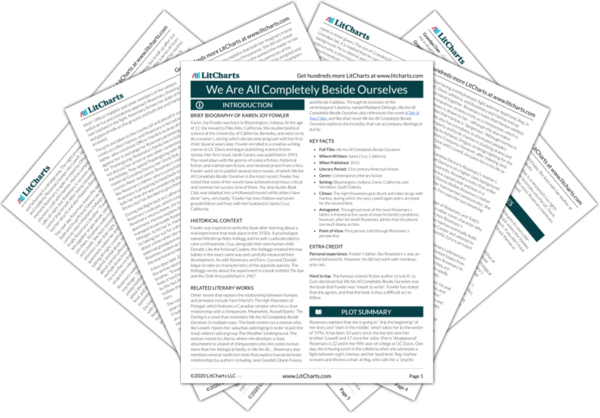Welcome to the LitCharts study guide on Karen Joy Fowler's We Are All Completely Beside Ourselves. Created by the original team behind SparkNotes, LitCharts are the world's best literature guides.
We Are All Completely Beside Ourselves: Introduction
A concise biography of Karen Joy Fowler plus historical and literary context for We Are All Completely Beside Ourselves.
We Are All Completely Beside Ourselves: Plot Summary
A quick-reference summary: We Are All Completely Beside Ourselves on a single page.
We Are All Completely Beside Ourselves: Detailed Summary & Analysis
In-depth summary and analysis of every chapter of We Are All Completely Beside Ourselves. Visual theme-tracking, too.
We Are All Completely Beside Ourselves: Themes
Explanations, analysis, and visualizations of We Are All Completely Beside Ourselves's themes.
We Are All Completely Beside Ourselves: Quotes
We Are All Completely Beside Ourselves's important quotes, sortable by theme, character, or chapter.
We Are All Completely Beside Ourselves: Characters
Description, analysis, and timelines for We Are All Completely Beside Ourselves's characters.
We Are All Completely Beside Ourselves: Symbols
Explanations of We Are All Completely Beside Ourselves's symbols, and tracking of where they appear.
We Are All Completely Beside Ourselves: Theme Wheel
An interactive data visualization of We Are All Completely Beside Ourselves's plot and themes.
Brief Biography of Karen Joy Fowler
Karen Joy Fowler was born in Bloomington, Indiana. At the age of 11 she moved to Palo Alto, California. She studied political science at the University of California, Berkeley, and went on to do a master’s, during which she became pregnant with her first child. Several years later, Fowler enrolled in a creative writing course at UC Davis and began publishing science fiction stories. Her first novel, Sarah Canary, was published in 1991. The novel plays with the genres of science fiction, historical fiction, and mainstream fiction, and received praise from critics. Fowler went on to publish several more novels, of which We Are All Completely Beside Ourselves is the most recent. Fowler has noted that some of her novels have achieved enormous critical and commercial success (one of them, The Jane Austen Book Club, was adapted into a Hollywood movie) while others have done “very, very badly.” Fowler has two children and seven grandchildren and lives with her husband in Santa Cruz, California.
Get the entire We Are All Completely Beside Ourselves LitChart as a printable PDF.

Historical Context of We Are All Completely Beside Ourselves
Fowler was inspired to write the book after learning about a real experiment that took place in the 1930s. A psychologist named Winthrop Niles Kellogg and his wife Luella decided to raise a chimpanzee, Gua, alongside their own human child, Donald. Like the fictional Cookes, the Kelloggs treated the two babies in the exact same way and carefully measured their development. As with Rosemary and Fern, Gua and Donald began to take on characteristics of the opposite species. The Kelloggs wrote about the experiment in a book entitled The Ape and the Child, first published in 1967.
Other Books Related to We Are All Completely Beside Ourselves
Other novels that explore the relationship between humans and primates include Yann Martel’s The High Mountains of Portugal, which features a Canadian senator who has a close relationship with a chimpanzee. Meanwhile, Russell Banks’ The Darling is a novel that resembles We Are All Completely Beside Ourselves in multiple ways. The book centers on a woman who, like Lowell, rejects her suburban upbringing in order to join the (real) violent radical group The Weather Underground. The woman moves to Liberia, where she develops a close attachment to a band of chimpanzees who she comes to love more than her biological family. In We Are All…, Rosemary also mentions several nonfiction texts that explore human/primate relationships by authors including Jane Goodall, Diane Fossey, and Biruté Galdikas. Through its inclusion of the ventriloquest's dummy named Madame Defarge, We Are All Completely Beside Ourselves also references the novel A Tale of Two Cities,
and like that novel We Are All Completely Beside Ourselves explores the brutality that can accompany ideological purity.
Key Facts about We Are All Completely Beside Ourselves
- Full Title: We Are All Completely Beside Ourselves
- Where Written: Santa Cruz, California
- When Published: 2013
- Literary Period: 21st century American fiction
- Genre: Contemporary literary fiction
- Setting: Bloomington, Indiana; Davis, California; and Vermilion, South Dakota.
- Climax: The night Rosemary gets drunk and takes drugs with Harlow, during which she sees Lowell again and is arrested for the second time.
- Antagonist: Throughout most of the novel Rosemary’s father is framed as the cause of most his family’s problems; however, after his death Rosemary admits that she placed too much blame on him.
- Point of View: First person, told through Rosemary’s perspective
Extra Credit for We Are All Completely Beside Ourselves
Personal experience. Fowler’s father, like Rosemary’s, was an animal behaviorist. However, he did not work with monkeys, only rats.
Hard to top. The famous science fiction author Ursula K. Le Guin declared that We Are All Completely Beside Ourselves was the book that Fowler was “meant to write”; Fowler has stated that she agrees, and that the book is thus a difficult act to follow.












